+ Open data
Open data
- Basic information
Basic information
| Entry | Database: PDB / ID: 6n4a | ||||||
|---|---|---|---|---|---|---|---|
| Title | PII-like SbtB from Cyanobium sp PCC 7001 (apo) | ||||||
 Components Components | PII-like SbtB | ||||||
 Keywords Keywords | SIGNALING PROTEIN / Pii-like signalling protein / SbtB / cyanobacteria | ||||||
| Function / homology |  Function and homology information Function and homology informationregulation of nitrogen utilization / enzyme regulator activity / ATP binding / metal ion binding Similarity search - Function | ||||||
| Biological species |  Cyanobium sp. PCC 7001 (bacteria) Cyanobium sp. PCC 7001 (bacteria) | ||||||
| Method |  X-RAY DIFFRACTION / X-RAY DIFFRACTION /  SYNCHROTRON / SYNCHROTRON /  MOLECULAR REPLACEMENT / Resolution: 2.3 Å MOLECULAR REPLACEMENT / Resolution: 2.3 Å | ||||||
 Authors Authors | Kaczmarski, J.A. / Jackson, C.J. | ||||||
 Citation Citation |  Journal: Biorxiv / Year: 2019 Journal: Biorxiv / Year: 2019Title: Structure and function of SbtB from Cyanobium sp. 7001 Authors: Jackson, C. / Kaczmarski, J.A. / Price, D. | ||||||
| History |
|
- Structure visualization
Structure visualization
| Structure viewer | Molecule:  Molmil Molmil Jmol/JSmol Jmol/JSmol |
|---|
- Downloads & links
Downloads & links
- Download
Download
| PDBx/mmCIF format |  6n4a.cif.gz 6n4a.cif.gz | 108.7 KB | Display |  PDBx/mmCIF format PDBx/mmCIF format |
|---|---|---|---|---|
| PDB format |  pdb6n4a.ent.gz pdb6n4a.ent.gz | 84.3 KB | Display |  PDB format PDB format |
| PDBx/mmJSON format |  6n4a.json.gz 6n4a.json.gz | Tree view |  PDBx/mmJSON format PDBx/mmJSON format | |
| Others |  Other downloads Other downloads |
-Validation report
| Summary document |  6n4a_validation.pdf.gz 6n4a_validation.pdf.gz | 442.5 KB | Display |  wwPDB validaton report wwPDB validaton report |
|---|---|---|---|---|
| Full document |  6n4a_full_validation.pdf.gz 6n4a_full_validation.pdf.gz | 450.3 KB | Display | |
| Data in XML |  6n4a_validation.xml.gz 6n4a_validation.xml.gz | 12.3 KB | Display | |
| Data in CIF |  6n4a_validation.cif.gz 6n4a_validation.cif.gz | 18.1 KB | Display | |
| Arichive directory |  https://data.pdbj.org/pub/pdb/validation_reports/n4/6n4a https://data.pdbj.org/pub/pdb/validation_reports/n4/6n4a ftp://data.pdbj.org/pub/pdb/validation_reports/n4/6n4a ftp://data.pdbj.org/pub/pdb/validation_reports/n4/6n4a | HTTPS FTP |
-Related structure data
- Links
Links
- Assembly
Assembly
| Deposited unit | 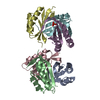
| ||||||||
|---|---|---|---|---|---|---|---|---|---|
| 1 | 
| ||||||||
| 2 | 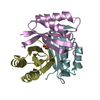
| ||||||||
| Unit cell |
|
- Components
Components
| #1: Protein | Mass: 11396.966 Da / Num. of mol.: 6 Source method: isolated from a genetically manipulated source Source: (gene. exp.)  Cyanobium sp. PCC 7001 (bacteria) / Gene: CPCC7001_1671 / Production host: Cyanobium sp. PCC 7001 (bacteria) / Gene: CPCC7001_1671 / Production host:  #2: Chemical | #3: Water | ChemComp-HOH / | |
|---|
-Experimental details
-Experiment
| Experiment | Method:  X-RAY DIFFRACTION / Number of used crystals: 1 X-RAY DIFFRACTION / Number of used crystals: 1 |
|---|
- Sample preparation
Sample preparation
| Crystal | Density Matthews: 2.14 Å3/Da / Density % sol: 42.49 % |
|---|---|
| Crystal grow | Temperature: 291 K / Method: vapor diffusion / Details: 25 mM Na2H/KH2PO4 20% PEG 3350 |
-Data collection
| Diffraction | Mean temperature: 100 K / Serial crystal experiment: N |
|---|---|
| Diffraction source | Source:  SYNCHROTRON / Site: SYNCHROTRON / Site:  Australian Synchrotron Australian Synchrotron  / Beamline: MX1 / Wavelength: 0.953657 Å / Beamline: MX1 / Wavelength: 0.953657 Å |
| Detector | Type: ADSC QUANTUM 210r / Detector: CCD / Date: Jun 12, 2018 |
| Radiation | Protocol: SINGLE WAVELENGTH / Monochromatic (M) / Laue (L): M / Scattering type: x-ray |
| Radiation wavelength | Wavelength: 0.953657 Å / Relative weight: 1 |
| Reflection | Resolution: 2.3→49.03 Å / Num. obs: 24704 / % possible obs: 98 % / Redundancy: 3.8 % / Net I/σ(I): 15.2 |
| Reflection shell | Resolution: 2.3→2.38 Å / Redundancy: 3.8 % / Num. unique obs: 2386 / CC1/2: 0.574 / % possible all: 95.2 |
- Processing
Processing
| Software |
| ||||||||||||||||||
|---|---|---|---|---|---|---|---|---|---|---|---|---|---|---|---|---|---|---|---|
| Refinement | Method to determine structure:  MOLECULAR REPLACEMENT / Resolution: 2.3→49.03 Å / Cross valid method: THROUGHOUT / MOLECULAR REPLACEMENT / Resolution: 2.3→49.03 Å / Cross valid method: THROUGHOUT /
| ||||||||||||||||||
| Displacement parameters | Biso max: 141.6 Å2 / Biso mean: 75.1516 Å2 / Biso min: 32.46 Å2 | ||||||||||||||||||
| Refinement step | Cycle: LAST / Resolution: 2.3→49.03 Å
|
 Movie
Movie Controller
Controller









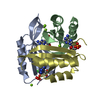
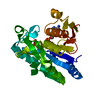
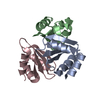
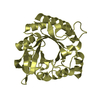
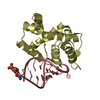
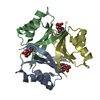


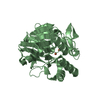
 PDBj
PDBj


